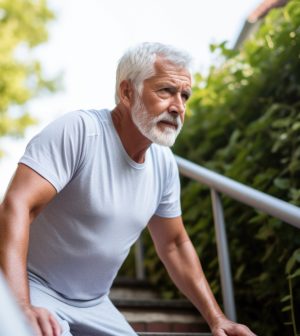- Understanding the Connection Between Anxiety and Depression
- How Daily Prunes Can Influence Cholesterol and Inflammation
- When to Take B12 for Better Absorption and Energy
- Epsom Salts: Health Benefits and Uses
- See What Saffron Can Do for Sleep and Heart Health
- 6 Common Mistakes to Avoid Before Your Physical
- Can Sweating Really Help You Beat a Cold?
- Strengthening Your Relationship: Practical Strategies
- Skip Storing This Everyday Product in the Fridge Door
- Green Tea + B3 Pairing May Boost Brain Health
Add Some Impact to Your Exercise to Keep Aging Bones Strong

Putting a little pressure on your bones during exercise or daily activities might pay off in stronger bones as you age, new research suggests.
The study focused on a crucial part of the hip joint anatomy called the femoral neck.
Finnish researchers found that largely sedentary folks ages 70 to 85 maintained or gained bone strength in the femoral neck after a year-long exercise program.
The key was the intensity and “impact” of physical activity. For example, people who engaged in running or brisk walking benefited far more than those who walked at a normal pace.
Even in your 70s and 80s, adding in this kind of activity to your daily routine is easily done, said study co-author Tuuli Suominen.
“It is possible to incorporate more high-intensity activity into your everyday life in small bouts, such as brisk walks and stair climbing,” said Suominen, a postdoctoral researcher at the University of Jyväskylä in Finland. “Jumping-like impacts can also be achieved without the actual jumping by first raising up on your tiptoes and then dropping down onto your heels.”
As physical activity tends to decline with advancing age, so does bone density and integrity. Can that deterioration be halted or slowed?
To find out, the researchers had 299 largely sedentary men and women ages 70 and older engage in a yearlong program focused on muscle strength, endurance, balance and flexibility training.
The program started out easy and progressed to more strenuous activities, and the amount and intensity of physical activity was tracked before and after six months of training.
The Finnish team also used high-tech X-ray technology to track the bone density and structural properties of the hip joint’s femoral neck.
“More daily moderate and high-intensity physical activity was related to less decline in bone mineral density” in the femoral neck, the team reported in the January issue of the journal Bone.
“Even short bursts of activity can be significant for the skeleton, so we also looked at movement in terms of the number and intensity of individual impacts,” study co-author Tiina Savikangas explained in a university news release.
“For example, walking and running cause impacts of different intensities,” said Savikanga, who is also a postdoctoral researcher at the university. “We found that impacts that were comparable to at least brisk walking were associated with better preservation of bone mineral density.”
More information
Find out more about links between exercise and bone health at the National Institute of Arthritis and Musculoskeletal and Skin Diseases.
SOURCE: University of Jyväskylä, news release, Jan. 15, 2024; Bone, January 2024
Source: HealthDay
Copyright © 2026 HealthDay. All rights reserved.










